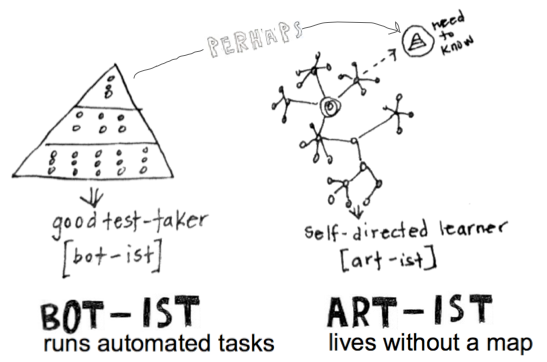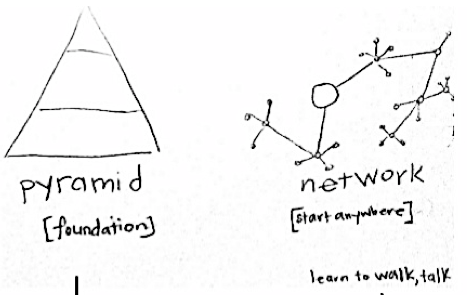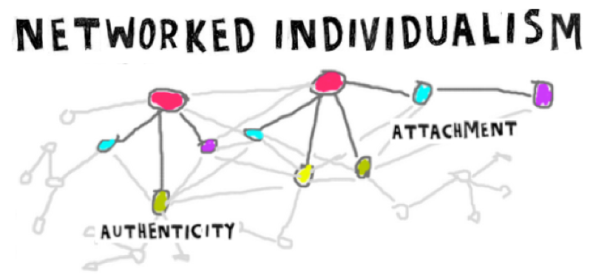david weinberger

[boston, ma]
favorite part (of too big to know – everything is misc.. begs we let go):
The pyramid illustrates our thinking about thinking (and life) the last couple hundred of years. The network is what is natural. The web is helping us to see that dimensionality. [x-d glasses – ness]
The one thing the pyramid has that the network doesn’t, is a foundation.
Perhaps, there are no basics, no foundation.

Perhaps the better pyramids are pruned to the individual or the moment/demand – of just-in-time, need-t0-know learning. Perhaps that is how our days get longer.. and we find we have all we need. [Fried’s rework]

Perhaps some other resemblances..


including our most useful skills.. walking and talking…

___________________________________
find/follow David:
http://en.wikipedia.org/wiki/David_Weinberger
https://twitter.com/dweinberger
______________________
book links to amazon
___________________________________
Schools teach but a billionth of a percent of the knowledge in the world, yet we quibble endlessly about which billionth of a percent is important, and the order in which is should be presented. – Seymour Papert
____________________________________
But this tendency to flock may be keeping us from finding the information we need,” and the tools we’ve built for the Internet only enhance our flocking bias.
“Creativity is an import-export business,” he said, the result of a cross-pollination of ideas and cultures that compels people to reflect on their assumptions. Those who are open to diversity and cognitive border-crossings, explained Zuckerman, “are at high risk of having good ideas.”
Zuckerman believes that change is possible. “If we don’t like how the Internet works now, we can fix it.” He recommended, for example, his own Berkman project called Global Voices, which shares online content from around the world. “It’s incumbent on us not to be satisfied with our tools,” and to build new ones that correct for our blind spots, he said.
23 min – how to build better tools for connecting
24 – not sure if i want my friends pre-filtering for me.. the tools of social search may be driving us into the same circles
26 – creative is an import/export business. thieves.
27:30 – how to take advantage of incredible cognitive diversity
28 – we could have an alternative:
a conversation of what we want
if we don’t like how the internet works – we can fix it
30 – how do you track your own behavior
we’ve gotten so good at tracking our bodies – but not our minds…
cognitive tracking
follow bias
41 – we live in an era where we don’t need to have close ties – as far as what used to force us to be close
44 – what does it mean to make diverse ties with others.. that let’s you care enough about them to tie you over
47 – what sort of ties do we need now?
53 – we don’t know what connects – we guess at what connects
59 – quality journalism is about engineering empathy – connecting with someone you wouldn’t ordinarily connect with
1:00 – david’s initial comment/sentiment – man…
1:06 – serendipity – ed to cultivate desire – other is something we do – interest – in things we had no idea we were interested in
1:08 – structured serendipity will just look like noise, unless something is mixed in – empathy not enough – has to have a quality of great journalism or art of ….. we need paul simon-ish bridge
1:09:45 – ethan – end of book – we can do many things for you – but we can’t create desire – curation/search/social – to perhaps serendipity – taking you somewhere out of what you know and what you’ve encountered..
[so – perhaps curiosity – in the city – as the day…?]
1:11:49 – perhaps it’s the word – engineering – that is tripping us up
________________
connection (love) between Ethan and David is of great insight
________________
reading rewire intro’d to David’s – miscellaneous:

book links to amazon
_____________
notes on book:
______________
notes from 2nd read:
we have to get rid of the idea that there’s a best way of organizing the world.
we invest so much time in making sure our world isn’t misc
the solution to the overabundance of info is more info
there’s no limit to how many alums we can assemble. so we’re no longer forced to carefully construct a single spaced path through memory..
whimsy/stigmergy as our structure.. as the day..
the more ways our digital photos can be sorted, ordered, clustered and made sense of – the more misc they are – the better. …
memory becomes less what we have assembled and locked away and more what we can assemble and share
p 13
“The digital world thereby allows us to transcend the most fundamental rule of ordering the real world : Instead of everything having its place, it’s better if things can get assigned multiple places simultaneously.
the chaos.. the fomo ness…
18
from atoms… can only be in one spot at a time.. to bits.. this third order removes the limitations we’ve assumed were inevitable in how we organize info
20
the immateriality of bits encourages corbis to put its images in every place where people might look for them
21
flickr has no professional cataloger. it relies solely on the labels users make up for themselves, w/o control or guidance.
22
2nd order organization, it turns out, is often as much about authority as about making things easier to find.
we can confront misc directly in all it unfulfilled glory. we can do it ourselves and , more significantly, we can do it together, figuring out the arrangements that make sense for us now and the new arrangements that make sense a minute later.
emergent.. structure… looking like unstructure
23
the misc order is not transforming only business. it is changing how we think the world itself is organized and -perhaps more important- who we think has the authority to tell us so.
whimsy/heart matters. as the day.
34 – ch 2 on alphabet
drawing lines has real consequences, and that elites use arbitrary lines to stay in power.
45
because of the limits of second0order media, such as paper, we’ve had to pick some orderings over others, a limit the third order of order removes.
rhizomatic ness… rev of everyday life ness
56
there is no end to it. the dewey decimal classification system can’t be fixed because knowledge itself is unfixed. knowledge is diverse, changing, imbued with the cultural values of the moment.
59
amazon hoping for – planned serendipity
________
notes from first read:
1st order – like shelves in store.. you can only put an item in one place – physical
Classification is a power struggle—it is political—because the first two orders of order require that there be a winner.Knowledge, we’ve thought, has four characteristics, two of them modeled on properties of reality and two on properties of political regimes.
Experts can be helpful, but in the age of the miscellaneous they and their institutions are no longer in charge of our ideas.
_________________________
Michael Wesch‘s 2011 rethinking ed:
4 min – if you’ve got enough links… you don’t need the hierarchy anymore.. there is no shelf. there is no filing system. links alone are enough.
from internet’s own boy, Tim Berners-Lee:
25 min – Tim – lots of little webs aren’t going to work – ..
..it’s not going to work unless the whole planet can get onboard
_________________________
june 2015 – share via Ethan on twitter:
In the past I would have said that so long as this architecture endures, so will the transfer of values from that architecture to the systems that run on top of it. But while the Internet’s architecture is still in place, the values transfer may actually be stifled by the many layers that have been built on top of it.
In short, my fear is that the Internet has been paved. You can spend an entire lifetime on the Internet and never feel its loam between your toes.
[..]
If I adjust my Nest thermostat, I’m using the Internet, but does anyone think that that encourages me to adopt so-called Internet values? The case is stronger if we talk about the web instead of the Internet, but in the Age of Apps, the web is in decline.
[..]
over time, the Internet escaped from its creators’ intentions. It became a way to communicate person-to-person via email and many-to-many via Usenet. The web came along and the prototypical example became home pages. Social networking came along and the prototype became Facebook. Mobile came along and the prototype became apps—although I’m not convinced that this last step has actually happened.
Keep in mind that a prototype is simply what is taken to be a clear, unambiguous example of something. It leaves plenty of room for less clear examples.
[..]
if users don’t come into contact with the Internet’s architecture, that architecture can’t shape them. If they instead deal almost exclusively with Facebook, then the conclusion of the Argument from Architecture ought to be that Facebook is shaping the values of its users. And Facebook’s values are not much like the Net’s.
[..]
So, it’s not just that many of us live in applications like Facebook, and never see the light of the Internet’s One True Architecture. Sandvig’s point means that even if you walk outside of your favorite application, the architecture itself has been distorted by the needs of commercial content creators and their enabling pals. Paradise has been well and truly paved.
[..]
hope:
1\ the Internet’s architecture still shows through many of the big corporate apps that are the Internet’s new pavement.
2\ the Internet is still there for entrepreneurs and generous spirits.
3\ open culture lives… there is a cadre of young folks, native to the Internet, who Get It…. infused with a spirit of play.
[..]
As the Internet’s architecture shapes our behavior and values less and less directly, we’re going to have to undertake the propagation of the values embedded in that architecture as an explicit task. We can encourage the development of sites and services that show off the Internet’s eclectic, improvisational skills.…. lots of things we can do.. we must do them all..
weaving the web ness – Tim
_________________________
_________________________
Does living with an explicit “taste of death in our mouths” (Montaigne) make life better? Make us more “authentic”?hyperorg.com/blogger/2015/1…My understanding, such as it is, of Heidegger’s idea of Being-toward-death is that our temporal finitude is constantly present as a horizon: we look before we cross the street because we know we can die — “know” not as an explicit thought but as the landscape within which our experience occurs. We make long-term plans within a horizon of possibility that we number in decades and not centuries.
https://www.brainpickings.org/2015/03/31/ongoingness-sarah-manguso/
..unable to inhabit the stillness of the middles. – @brainpicker – I enjoy continuing. – Sarah Manguso
_________
find/follow David:
I mainly write about the effect of tech on our ideas
http://www.hyperorg.com/blogger/
David Weinberger (born 1950) is an American technologist, professional speaker, and commentator, probably best known as co-author of the Cluetrain Manifesto (originally a website, and eventually a book, which has been described as “a primer on Internet marketing”). Weinberger’s work focuses on how the Internet is changing human relationships, communication, and society.
A philosopher by training, he holds a Ph.D. from the University of Toronto and taught college from 1980-1986. He was a gag writer for the comic strip “Inside Woody Allen” from 1976-1983. He became a marketing consultant and executive at several high-tech companies, and currently serves as a fellow at the Berkman Center for Internet and Society at Harvard Law School, where he co-teaches a class on “The Web Difference” with John Palfrey. In addition, he is Co-Director of the Harvard Library Innovation Lab at Harvard Law School. He had the title Senior Internet Advisor to Howard Dean’s 2004 presidential campaign, and provided technology policy advice to John Edwards’ 2008 presidential campaign.
_______
@dweinberger
Best convention in my lifetime. Changed what it means to be a Democrat, and retrieved what it means to be American. hyperorg.com/blogger/2016/0…
on 71% ness none of us free if one of us chained public consensus oppresses we have means to do better (which i learned from you)
__________
Season 3 Finale of “Trump!” (@dweinberger) tweeted at 4:34 AM – 18 Jan 2019 :
Sounds like it would have been a great example for my upcoming book about the change in how we think the future works. #EverydayChaos https://t.co/ewJS4kGeGU @HarvardBiz https://t.co/FTLgLWigd3 (http://twitter.com/dweinberger/status/1086225260314279936?s=17)@BaseCase
A lot of programmers make the mistake of thinking the way you make code flexible is by predicting as many future uses as possible, but this paradoxically leads to *less* flexible code. The only way to achieve flexibility is to make things as simple and easy to change as you can.
antifragile.. ie: cure ios city
on book:
joi: With classic Weinberger wit and brilliant insight, this book shatters the myth of predictability while delivering grounded, actionable advice for anyone trying to thrive in the everyday chaos that has become our world. A page-turning, must-read for everyone.
suggested to buy at library – thanks library
everyday chaos
______
Joi Ito (@Joi) tweeted at 5:42 AM – 14 May 2019 :
Talking with @dweinberger about his book at @BKCHarvard this evening at 7PM tonight – Everyday Chaos https://t.co/UqwOTNAv4F (http://twitter.com/Joi/status/1128264244204658688?s=17)whole decision making thing via military.. entirely inappropriate’ – paraphrase
data is construct – all based on human decisions.. who’s going to decide.. ie: this is useful and not.. these issues are thoroughly entrenched in the human
what if that isn’t what (eudaimoniative surplus) humanity is about..
(when) the cause is so enormously complex.. so many other things in place.. explanations then.. really not.. things so deeply caused.. even though you can find a short distance thing to do .. not really an explanation of why
explanations are usually about fixing a problem
________
from joi
My reading list with links to related talks, posts and classes: https://t.co/VdnlEDHAsQ
Original Tweet: https://twitter.com/Joi/status/1128964437514293248
includes:
explanation as orgasm (article), gopnik
I argue that explanation should be thought of as the phenomenological mark of the operation of a particular kind of cognitive system, the theory-formation system. The theory-formation system operates most clearly in children and scientists but is also part of our everyday cognition. The system is devoted to uncovering the underlying causal structure of the world. Since this process often involves active intervention in the world, in the case of systematic experiment in scientists, and play in children, the cognitive system is accompanied by a ‘theory drive’, a motivational system that impels us to interpret new evidence in terms of existing theories and change our theories in the light of new evidence. What we usually think of as explanation is the phenomenological state that accompanies the satisfaction of this drive. However, the relation between the phenomenology and the cognitive system is contingent, as in similar cases of sexual and visual phenomenology. Distinctive explanatory phenomenology may also help us to identify when the theory-formation system is operating.
_______

























